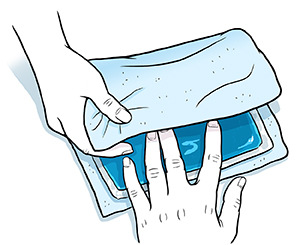El síndrome de la banda iliotibial (IT) es una afección que causa dolor en la parte externa de la rodilla. Suele presentarse en atletas. Es más frecuente en los corredores de largas distancias. Puede aparecer si anda en bicicleta, esquía, rema o juega al fútbol. También en las personas que comienzan a ejercitar.
Tipos de tratamiento
El tratamiento puede incluir lo siguiente:
-
Tomar un descanso de la actividad que empeora el dolor de rodilla (como correr) y retomarla lentamente con el tiempo
-
Aplicar hielo sobre su rodilla cuando le duela
-
Usar analgésicos de venta libre
-
Recibir inyecciones de corticoesteroides para reducir la inflamación
-
Hacer cambios en la actividad, como bajar el asiento de la bicicleta o mejorar la forma de correr
-
Hacer ejercicios para estirar y fortalecer los músculos alrededor de la cadera y la rodilla
Puede ser útil trabajar con un fisioterapeuta.
Estos tratamientos ayudan a la mayoría de las personas con síndrome de banda IT. El médico puede recomendarle una cirugía si aún tiene síntomas graves después de 6 meses o más de otro tratamiento. El médico hablará con usted sobre los tipos de cirugía.
Prevención del síndrome de la banda IT
Para prevenir el síndrome de la banda IT, haga lo siguiente:
-
Corra en superficies uniformes
-
Reemplace el calzado para correr con frecuencia
-
Disminuya la intensidad del entrenamiento
-
En una pista, asegúrese de correr en ambas direcciones
-
Haga que un experto verifique su postura para correr y practicar otros deportes
-
Estire la parte externa del muslo y los isquiotibiales con frecuencia
Si empieza a ejercitar, comience de a poco. Aumente la actividad con el tiempo.
Hable con el proveedor de atención médica o entrenador para obtener más consejos.
Cuándo llamar al proveedor de atención médica
Llame de inmediato a su proveedor de atención médica en cualquiera de los siguientes casos:
-
Síntomas que empeoran o que no se alivian con el tratamiento
-
Síntomas nuevos


